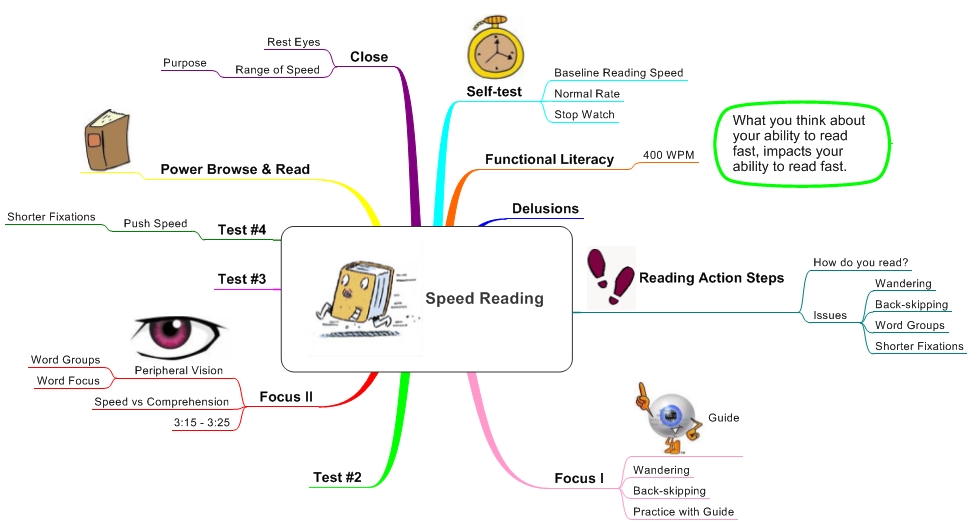An Idea Mapping Success Blogs Weblog
Speed Reading – Idea Map #147
17Mar2009 Filed under: Idea Mapping Example, Mind Mapping Examples, Speed Reading Author: Jamie NastThe following article is featured as part of the March Mindjet newsletter that will be published later today.
Use MindManager to Read and Comprehend Information More Quickly
Do you ever wish you were able to understand and respond to information more quickly? Today I’ll walk you through a map I believe is guaranteed to provide some vast improvements – Speed Reading.
We all know you wouldn’t want to speed through a great novel, but in the right circumstances this skill can save you considerable time when you choose to “turn it on.”
Here are some essential resources you’ll need to start your journey towards Speed Reading:
– A stop watch
– Four articles between 800 and1200 words in length. I copy articles from the Internet and put them into Microsoft Word. Then I go to the ‘Spelling & Grammar’ section in Word’s ‘Tools’ tab. Before running a Spell Check, I go to the Spelling ‘Options’ section to make sure the ‘Readability Statistics’ box is checked. Now I run the Spell Check and the application tells you exactly how many words you have in the document.
Establish a Baseline
Now you’re ready to measure your reading speed. Start the stop watch and read the entire article AT YOUR NORMAL READING SPEED. When finished with the article, note how long it took to read it and then calculate the number of words you read per minute.
Understand Functional Literacy
About 20 years ago the United Nations established a minimum reading rate they thought people needed to achieve in order to be “functionally literate”, 400 words per minute (WPM).. Now don’t panic if your initial reading speed was lower than this number. Mine was way below the 400 WPM baseline when I began to foster Speed Reading skills. Remember, it can only get better from here!
Be Aware of Reading’s Delusions
There are many delusions about reading which include:
- It’s impossible to read at 1000 WPM
- You should stop every time you don’t know what a word means and look it up in the dictionary.
- You need to remember what you read, word by word, line by line.
- You should never use your finger as a guide. Why? I’ve never had anyone give me a good reason.
Take Action
If you could see your eyes when you read they would move across the page in a very jerky manner, they would skip back, sometimes wander off the page, see one word at a time, and get stuck or fixated on certain words. These are the topics we’ll focus on today.
Use a Guide
A Guide is going to help with wandering and back-skipping. Think about it, when you look up a number in the phone book what do you do? Our elementary teaches didn’t know what they were talking about. Using a guide doesn’t slow you down. It keeps you focused and head in a forward direction. Take a pen, finger, or something else you’ll use as a guide and practice reading the first article you read for the baseline test above. When you’re ready, take article #2 and begin reading also using your guide. Time yourself again.
Retain Peripheral Vision
As you push your speed you may feel like you’re losing comprehension. You have to push the speed until your brain gets used to the faster pace.
Let’s try this exercise. First, start by starting at this WORD right here. How many words can you see to the left or right of the WORD without looking to the left or right but only starring at that one WORD? Notice what you can see above and below you. Still starring at the WORD, what can you see off the computer screen? Now you’re going to use your guide to point to word groupings. Even if you only take in one or two more words than you have in the past, you’re still saving time. Try this technique along with a guide as you time yourself on article #3.
Challenge Your Speed
When practicing Speed Reading using article #4 try pushing your speed even more. Try to lessen fixations, or the amount of time your eyes spend looking at word groupings.
Continue to Read
Finally, when reading a novel always thumb through it first before you read it. You’ll get a good feel for what is to come. Then begin applying these techniques to written work beyond novels, such as articles, manuals, etc. If you’re taking notes as you go, make sure you have MindManager handy to organize and capture your thoughts!
Rest Your Eyes
Rest your eyes occasionally. Remember the speed at which you choose to read will be determined by your purpose for reading.
2 Responses to “Speed Reading – Idea Map #147”
Leave a reply
Idea Mapping Blog
The purpose of this blog is to share idea mapping examples and related learning from my Idea Mapping, Memory, Speed Reading, and Certification Workshops. This blog is dedicated to my Certified Idea Mapping Instructors, my clients, Mind Mapping and Idea Mapping practitioners around the globe.

![[Ask]](http://ideamapping.ideamappingsuccess.com/IdeaMappingBlogs/wp-content/plugins/bookmarkify/ask.png)
![[del.icio.us]](http://ideamapping.ideamappingsuccess.com/IdeaMappingBlogs/wp-content/plugins/bookmarkify/delicious.png)
![[Digg]](http://ideamapping.ideamappingsuccess.com/IdeaMappingBlogs/wp-content/plugins/bookmarkify/digg.png)
![[Facebook]](http://ideamapping.ideamappingsuccess.com/IdeaMappingBlogs/wp-content/plugins/bookmarkify/facebook.png)
![[Google]](http://ideamapping.ideamappingsuccess.com/IdeaMappingBlogs/wp-content/plugins/bookmarkify/google.png)
![[MySpace]](http://ideamapping.ideamappingsuccess.com/IdeaMappingBlogs/wp-content/plugins/bookmarkify/myspace.png)
![[Slashdot]](http://ideamapping.ideamappingsuccess.com/IdeaMappingBlogs/wp-content/plugins/bookmarkify/slashdot.png)
![[Sphinn]](http://ideamapping.ideamappingsuccess.com/IdeaMappingBlogs/wp-content/plugins/bookmarkify/sphinn.png)
![[StumbleUpon]](http://ideamapping.ideamappingsuccess.com/IdeaMappingBlogs/wp-content/plugins/bookmarkify/stumbleupon.png)
![[Technorati]](http://ideamapping.ideamappingsuccess.com/IdeaMappingBlogs/wp-content/plugins/bookmarkify/technorati.png)
![[ThisNext]](http://ideamapping.ideamappingsuccess.com/IdeaMappingBlogs/wp-content/plugins/bookmarkify/thisnext.png)
![[Twitter]](http://ideamapping.ideamappingsuccess.com/IdeaMappingBlogs/wp-content/plugins/bookmarkify/twitter.png)
![[Webride]](http://ideamapping.ideamappingsuccess.com/IdeaMappingBlogs/wp-content/plugins/bookmarkify/webride.png)
![[Email]](http://ideamapping.ideamappingsuccess.com/IdeaMappingBlogs/wp-content/plugins/bookmarkify/email.png)
christianroy.tumblr.com
March 17th, 2009 at 9:22 pm
Une carte mentale sur la lecture rapide…
Jamie Nast résume des techniques de lecture rapide dans une carte mentale, accompagnée dun texte simple qui explique comment sy mettre. Pratique pour sa simplicité et son accessibilité….
Speed Reading with MindManager | The Mindmap Blog
March 24th, 2009 at 6:57 pm
[…] To read the full article, click here. […]